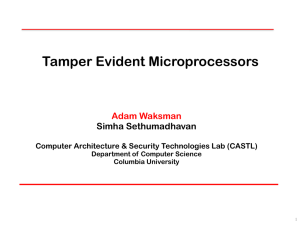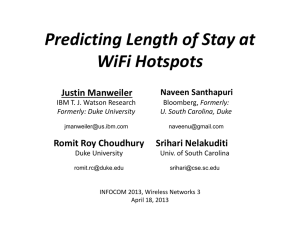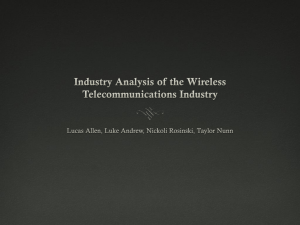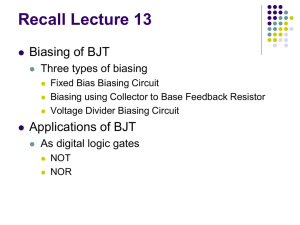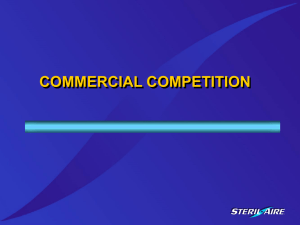From Fixed Scan Scheduler (FSS) to Dynamic Scan Scheduler (DSS)
advertisement
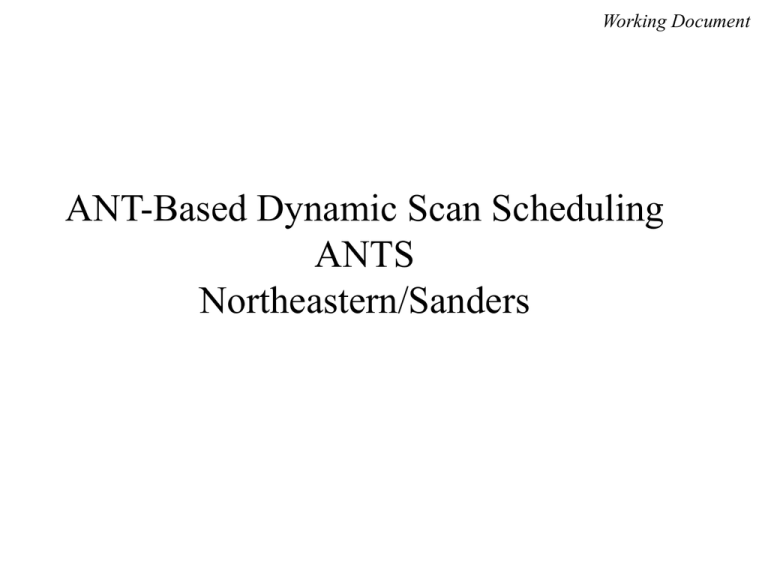
Working Document
ANT-Based Dynamic Scan Scheduling
ANTS
Northeastern/Sanders
Working Document
Outline
• The scheduling problem
• Use Case: Fixed Scan Scheduler
• From FSS to Dynamic Schan Sched. (DSS)
• Dynamic Scheduling via negotiation
• Plans
Working Document
Scenario
A
B
C
Working Document
Scenario - discussion
Consider a threat pulsed radar in surveillance mode with pulse-repetition interval in the
order of 1 msec (200-km unambiguous range). (The interval can be as small as 10 s.) The
principal lobe of its antenna pattern is a fan beam in elevation with a 1-deg azimuth beamwidth.
The beam scans 360 deg in 3 sec. Therefore, its illumination time at a point fixed in the far field
will be 8 msec. (3sec/360)
~
The desired EW-receiver revisit time, T , is therefore 8 msec. This is the largest time interval that
guarantees that the illumination of the threat can be captured by the EW receiver (the receiver’s
dwell time and the emitter’s illumination time intervals will overlap).
At least three pulses must be detected in order for the EW receiver to correctly identify the emitter.
(Parameter M on next page: M >=3.) Therefore, the EW-receiver dwell cannot be less than 3
msec. This assumes that the Pulse Repetition Interval (PRI) is 1msec . If PRI is smaller than 1msec,
then the dwell time can be shorter.
Working Document
Emitter Signal
Emitter Parameters
Time
Pulsewidth
Pulse-repetition interval
Illumination time
Emitter revisit time
Desired EW revisit time = Emitter illumination time
Desired EW dwell = M × emitter PRI (M is an integer)
Working Document
Scenario-numbers
• Number of emitters:
• Emitters to track:
• Average dwell time:
• Revisits per second:
2000
50-200
3-30 msec
2
•If tracking 50 emitters, using 10mSec dwell times each, how many revisits per Sec?
1,000 ms/(50 x 10ms) = 2 max.
Working Document
Fixed Scan Scheduler (FSS)
Definition: Using prior knowledge, mission
planners construct a Static, Mission-Specific
Scan Schedule or a “Fixed Scan Schedule” offline for use during future missions.
Working Document
Fixed Scan Schedule Construction
Collect Information
Intelligence
Develop FSS
Evaluate QoS
Planner
Environment
Update Prior Knowledge
<<include>>
Execute FSS
Crew
Load FSS
Measure Env
Track
Generate Trace
Working Document
FSS: Example
Em itter
Priority
A
4
B
2
C
1
Schedule
A1
B1
A2
B2
A3
C1
A4
Working Document
Parameters - continued
Assume a K number of EW receivers are provided, each covering an instantaneous
bandwidth f.
Assume the spectral region of surveillance covers a frequency range from f1 to f2.
Therefore, the surveillance coverage consists of L number of bands any
K of which can be covered instantaneously
If
K L f 2 f1 f
then we have a problem (cannot cover all)
A threat list of emitters of interest shows that they operate in only L’ of the L
frequency bands from f1 to f2.
Working Document
Parameters -cont.
Frequency band l of the L‘ bands contains an Ml number of emitters, each having
a desired revisit time Tlm and desired dwell lm , m = 1, 2, , Ml .
f1
f2
If lm > ln , then whenever the EW system revisits emitter m, it will also revisit
emitter n, provided that revisit time is Tlm and it is the smallest
In other words:
Trevisit = min {Tlm ,Tln}
dwell = max {lm , ln}
Working Document
Constraints on parameters
Tn EW revisit time for nth emitter.
n EW dwell time for nth emitter.
N
Constraint:
T
n 1
~
T n Desired EW revisit ti me
n
1
n
= Emitter illumination time
~
~n Desired EW dwell M n n th Emitter PRI
~
M n Number of nth-emitter pulses desired to be available for
opportunity of interception.
~
If T n T n and n ~n
cannot satisfy the constraint, must compromise with
~
T n T n and n ~n
Consequence is degradation of probability of intercept.
Working Document
What follows
•There are two aspects to scheduling receivers:
– performance of a receiver (Measure of
Effectiveness (MOE), when and for how long) and
– the value of that performace to the system (Figure
of Merit (FOM), how important is that threat)
• The following slides focus on MOEs for
receivers
Working Document
Metric of Scan-Schedule Performance
Example 1 (one pulse)
Suppose
n ~n
Rn Event that EW receiver is ready to receive transmission from nth emitter
when transmission occurs.
In Event that EW receiver intercepts transmission from nth emitter.
PI n Prob I n Prob I | R Pr n
Pr n
~
If T n T n , then Pr n 1, thereby degrading
PI n .
~
Tn
Prob R n min 1,
Tn
Working Document
Example 2 (three pulses)
R Event that the EW receiver is ready to receive emitter transmission when it occurs.
p Conditional probability of EW receiver detecting a pulse when it occurs, given that the EW receiver is queued to receive it.
I Event that EW receiver detects at least three of the emitter pulses.
Prob I Prob I R Prob R
~
Prob R min 1, T
Prob I R
n3
T
0,
when 3
p n 1 p n , when 3
n
x Greatest integer in x. x x
Working Document
Example 3 (Mn pulses)
Suppose
~
Tn Tn
Mˆ n
Minimum number of pulses intercepted that is required to perform
task (detection, emitter identification, direction finding).
I n Event that EW receiver intercepts Mˆ n
number of emitter pulses.
Suppose EW receiver dwells long enough for emitter to transmit Mn pulses.
PI n Prob I n
M
n
k Mˆ
n
Mn k
M k
p n 1 p n n
k
M n Mˆ n
pn Probability of detecting a pulse from nth emitter.
The longer the dwell n, the larger Mn and the the higher PIn.
Working Document
MOEs
• Now we focus on MOEs for the Scheduler
• The following slides need to be reviewed
Working Document
Resources, Tasks and Constraints
Resource
Tasks
Figures of Merit
Time
Search
Detection range; Probability of report;
Probability of Intercept
Track
Accuracy of track: Direction, signal parameters
(frequency, pulsewidth, pulse-repetition interval,
modulation parameters, etc.)
Whether or not performed and consequences
if not performed (degradation in FOM of
other two tasks.)
Compensation
Tn EW revisit time for nth scan state.
n EW dwell time for nth scan state.
N
Constraints
n 1
n
Tn
1
A scan state services
one or multiple
emitters
simultaneously.
Compensation is
performed during
other scan states.
Probability of mis-identifying a non-threat as a threat must be kept
very low. For example, classifying a civilian airliner as a lethal
threat must be vanishingly small before defensive action is
initiated.
Working Document
Two scenarios - two sets of MOEs
MISSION
Ingress
Must survive to complete
mission [destroying
target(s)].
Egress
Must survive to
get home intact.
Working Document
INGRESS (Surviving to hunt/destroy targets)
EW Search (Searching to protect against lethal threats)
RESOURCE
Required
Probability of Surviving, Probability of
Estimated Reaction Time Dwell Revisit
given that threat is
encountering
Threats
Time Time
Lethality
to Survive
encountered: P(S|)
threat: P()
Severe
Th1
P(1)
P(S1|1)
Th
Moderate
P(S2|2)
P(2)
P(SN|N)
P(N)
2
Th
N
N
Probability of surviving ingress part of mission
P S
n
n P n 1 P n
n 1
The shorter the dwell, or the longer the revisit time, the longer will be the
reaction time, and the lower will be the probability of surviving a threat when it is
encountered.
EGRESS is similar
Working Document
INGRESS (Success of hunt)
EW Search
(Searching for prey)
RESOURCE
Targets Value of
of Prey Destroying
Dwell Revisit
Time Time
Probability of
Detection, given that
target is encountered:
P(D|)
Probability of
encountering
target: P()
Tp1
v1
P(D1|1)
P(1)
Tp
v2
P(D2|2)
P(2)
P(DN|N)
P(N)
2
Tp
vN
N
EW Track &
Target Kill
RESOURCE
Targets
of Prey
Value of
Destroying
Dwell Track-Update
Time
Interval
Probability of Kill given
detection: P(K|D)
Tp1
v1
P(K1|D1)
Tp
v2
P(K2|D2)
2
Tp
N
vN
P(KN|DN)
The longer the
dwell time, or
the shorter the
track-update
interval, the less
likely will be a
loss of track,
and the more
likely will be
target
destruction.
Working Document
INGRESS, Cont. (Success of hunt)
Conditional mathematical expectation of total value of destruction, given that hunter survives
N
v
n 1
n
P K n | D n P D n | n P n
Working Document
From Fixed to Dynamic Scan Scheduling
There are many reasons for having dynamic scheduling
• New targets have been detected and need to be tracked
• The plane (with receivers on board) is moving and thus the relative illumination times
of various targets have changed (?)
• Terrain masking can suddenly disappear, as the aircraft travels, thereby exposing aircraft
to being detected
• Scheduler’s FOM (Figure of Merit) function changes since some emitters shifted their
operational mode:
• Surveillance mode PRF (1 kHz)
• Pulse Doppler PRF (10 to 20 kHz)
• Precision tracking (pencil antenna beam) pulse-Doppler PRF
• Additionally, emitters can change their characteristics
• Changing PRI (staggering), but fixed frequency
• Modulation
• Initial goal: detection? tracking varying emitter parameters?
(As
the emitter changes mode (and parameters), lethality can change: Emitter in surveillance mode detects aircraft vehicle and then
changes mode to precision track. When emitter reaches a fire-control solution, a surface-to-air missile is fired, and its radar seeker
begins transmitting.)
• Can simulate varying parameters with a dynamic process?
Working Document
Dynamic Scan Scheduler
Collect Information
Intelligence
Develop FSS
EvaluateQoS
Planner
Environment
Update Prior Knowledge
Execute DSS
Crew/MissionSW
Auto Update
Prior Knowl
Load Init FSS
Track
Auto Eval QoS
Measure Env
Update SS
Generate Trace
Working Document
Dynamic Scheduling through Negotiation
• Goal - mission: maximize probability of success of mission
• ingress: maximize probability of destruction of target(s)
• egress: maximize probability of survival (return home
intact)
• Goal must translate to a negotiation problem (conflicting
objectives for negotiating parties
• Sensor agent: maximize accuracy of tracking according to
priorities - initial goal
maximize probability of survival - next goal
minimize ratio of dwell time to revisit time
• Threat agent: minimize accuracyof tracking - initial goal
maximize probability of intercept - next goal
maximize ratio of dwell time to revisit time
Working Document
Negotiation Configuration
.
.
.
Sensor
Agent
Threat
Agents
Working Document
Schedule Negotiation
• Example (ingress):current threat situation = threat prob. vector
(P(1), P(2)…,P(N))
N
N
Maximize
P S
n 1
n
n P n 1 P n
Constraint:
n 1
n
1
Tn
• Seen as a resource sharing problem:
– resource = sensor utilization
– how much of it is available: 1
– to be shared between N threat agents
– each of these agents gets a fraction (n/Tn) of the resource,
where n = dwell-time allocated and Tn=revisit time allocated
to the agent.
Working Document
Schedule Negotiation (detection)
• Sensor agent: minimize (n/Tn)
– weigh according to threat priority
– as a first approximation
– subject to constraints
•
Threat agent: maximize (n/Tn)
• Open issues:
– ensure that real-time constraints are met
– how to take probability of threats (I.e P(e)) into account
• Dynamic scheduling:
– renegotiate the schedule when threat probability vector changes

